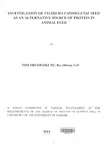Investigation of tylosema fassoglense seed as an alternative source of protein in animal feed
Abstract
Formulation of animal feeds entails use of various raw materials in order to come up with a final
product capable of meeting dietary needs of the animal under consideration. To achieve this goal,
animal and plant based raw materials are investigated for various nutritional components such as
amounts of proteins, carbohydrates, fats, fibre and minerals present in order to facilitate
formulation of the optimal nutritional feed. Plants of the leguminosae family are known to be
rich in the essential nutrients and are therefore used extensively in the animal feed industry.
Tylosema fassoglense is a member of the leguminosae family growing wildly in Western, Rift
valley and sections of North Eastern parts of Kenya. Various parts of the plant have several uses
among different communities; the plant seed is consumed, tuber used as medicine by some
communities in Western Kenya, while the leaves are used as pasture for livestock by some other
communities in Rift Valley and North Eastern parts of Kenya.
Local regulations specify recommended levels of the feed components for crude protein, crude
fat,total ash and mineral contents for dairy meal, pig feeds, poultry feeds and also raw materials
such as maize bran, cotton seedcake, sunflower seedcake and wheat bran. Ban on animal based
protein sources in ruminant feed by the European Union following the outbreak of mad cow
disease has pushed the local industry towards looking for additional plant based protein sources
for use in the feed formulation process. In the feed industry, crude protein sources are still
classified as the most expensive feed formulation component and therefore identification of
additional sources may lead to reduction in costs. Protein malnutrition is still a problem to poor
households in the developing world hence need to identify additional sources of protein.
Citation
Masters of science in ChemistrySponsorhip
University of NairobiPublisher
University of Nairobi Chemistry

